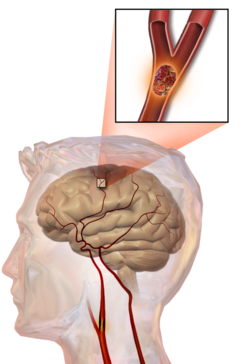Chapter 10 – Cardiovascular Disease and Stroke
Coronary heart disease—often simply called heart disease—is the main form of heart disease. It is a disorder of the blood vessels of the heart that can lead to heart attack. A heart attack happens when an artery becomes blocked, preventing oxygen and nutrients from getting to the heart. Heart disease is one of several cardiovascular diseases, which are diseases of the heart and blood vessel system. Other cardiovascular diseases include stroke, high blood pressure, angina (chest pain), and rheumatic heart disease. (NIH, 2017)
Types of Cardiovascular Disease
Arteriosclerosis
 Arteriosclerosis is a form of cardiovascular disease that involves a thickening and hardening of the arteries. Arteries narrow from deposits of fat, cholesterol, and other substances. These deposits, called plaques, accumulate on arterial walls and can restrict blood flow. Coronary arteries, which supply the heart with blood, and cerebral arteries, which supply the brain with blood, are particularly susceptible to plaque build-up. The blockage of a coronary artery causes a heart attack and the blockage of a cerebral artery causes a stroke.
Arteriosclerosis is a form of cardiovascular disease that involves a thickening and hardening of the arteries. Arteries narrow from deposits of fat, cholesterol, and other substances. These deposits, called plaques, accumulate on arterial walls and can restrict blood flow. Coronary arteries, which supply the heart with blood, and cerebral arteries, which supply the brain with blood, are particularly susceptible to plaque build-up. The blockage of a coronary artery causes a heart attack and the blockage of a cerebral artery causes a stroke.
Heart Attack
 A Myocardial Infarction (MI), otherwise known as a heart attack, is a medical emergency that occurs when blood flow to the heart muscle is blocked. Areas of the heart past this blockage may suffer damage or die.
A Myocardial Infarction (MI), otherwise known as a heart attack, is a medical emergency that occurs when blood flow to the heart muscle is blocked. Areas of the heart past this blockage may suffer damage or die.
Symptoms include crushing chest pains (Angina Pectoris), profound shortness of breath, left arm pain, radiating jaw pain, cold sweats, clammy skin, nausea, or middle back pain. (Note: that a person may feel multiple symptoms, or just one.)
These signs and symptoms of heart attack are very serious and should be recognized as soon as possible as this condition can lead to permanent heart damage or death.
What to do if you suspect someone having a heart attack:
- Call 911 or your local medical emergency number.
- Chew and swallow an aspirin (Take nitroglycerin, if prescribed.)
- Begin CPR if the person is unconscious.
- Use an automated external defibrillator (AED), if available
Stroke
 A stroke, also called a cerebral vascular accident (CVA), occurs when the blood supply to the brain is cut off. When brain cells are deprived of oxygen for more than a few minutes, they die. Depending on the area of the brain affected, a stroke may cause weakness or paralysis (often on only one side of the body), speech impairment, memory loss, and changes in behavior.
A stroke, also called a cerebral vascular accident (CVA), occurs when the blood supply to the brain is cut off. When brain cells are deprived of oxygen for more than a few minutes, they die. Depending on the area of the brain affected, a stroke may cause weakness or paralysis (often on only one side of the body), speech impairment, memory loss, and changes in behavior.
Most strokes are caused by a blockage in a blood vessel and are called an ischemic stroke. There are two types of ischemic strokes: 1) thrombotic – caused by a blood clot that forms in a cerebral or carotid artery; and 2) embolic – caused by an embolus, a clot that has formed elsewhere in the body and has been carried in the blood stream and becomes wedged in a cerebral artery.
Another type of stroke is a hemorrhagic stroke. A hemorrhagic stroke occurs when a blood vessel in the brain ruptures, leaking blood into the surrounding tissue. Brain cells are deprived of blood and accumulation of the blood from the burst vessel may put pressure on surrounding tissue, which can cause damage and even death. Only about 20% of strokes are hemorrhagic.
Early Warning Signs for Stroke:
F = Face: Is one side of the face drooping down?
A = Arm: Can the person raise both arms, or is one arm weak?
S = Speech: Is speech slurred or confusing?
T = Time: Time is critical!! Call 9-1-1 immediately!
High Blood Pressure
Blood pressure is the force of the blood exerted on the walls of the arteries, created by the pumping of the blood. It is expressed as two numbers – for example 120/80 – and measured in millimeters of mercury (mmHg). The first/higher number is the systolic pressure – the greatest pressure exerted as your heart beats. The second/lower number is the diastolic pressure, the lowest pressure when your heart relaxes between beats. Blood pressure is easily measured with a blood pressure cuff connected to a sphygmomanometer.
High blood pressure is a result of arterial resistance caused by the constriction of the smooth muscle surrounding the arteries or by arteriosclerosis. When someone has high blood pressure, the heart must work harder to force blood through the narrowed and/or stiffened arteries, straining both the heart and the arteries.

